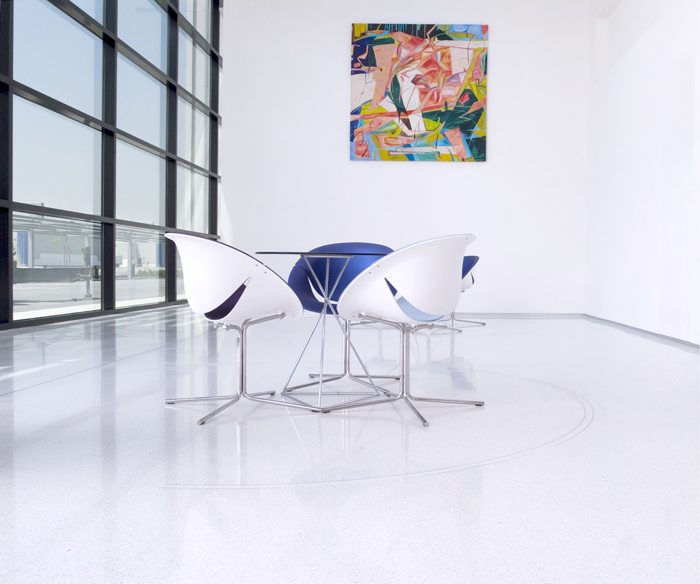The developers and managers of commercial spaces have to ensure that the building materials they choose are aesthetically pleasing and also cost-efficient, functional and able to withstand the inherent challenges of the location.
This is especially true of the flooring system, as on average the floor makes up one-sixth of a facilities’ entire surface, meaning that it is important to realise the full potential of this aspect of the building.
A well-designed floor can provide a wealth of benefits, as its design can help to create a vibrant and engaging customer experience, tie a location to a brand identity or even fulfil vital navigational and safety criteria. However if the chosen material is unable to cope with the anticipated level of traffic or with the inevitable spillages and wear then it can quickly fail and present an unsightly, unhygienic and potentially costly problem for the facilities manager.
Because of these issues developers are increasingly turning to seamless resin floors thanks to the many on-site advantages they hold over alternative solutions. Resin systems offer a wider choice of aesthetic possibilities whilst ensuring a durable surface that is hygienic, easy to clean and which minimises the need for repairs and refurbishments.
The many different types of resin floors available to the commercial sector means that there is a wide variety of different styles, colours and effects to choose from. This versatility means that there is a resin flooring solution for any location regardless of size, complexity or the image they want to portray.
A significant design benefit of specifying a resin floor is that it can be colour matched to any shade of the RAL colour palettes, which is ideal for locations eager to achieve a design scheme consistency or who want to assert a brand identity.
The seamless and impermeable nature of resin floors facilitates a sanitary environment, as the floor won’t harbour contaminants, can be easily cleaned and its hard wearing and chemically resistant finish won’t crack or erode when faced with harsh cleaning chemicals, foot traffic and continuous use.
Bespoke floor designs, including complex geometric shapes, corporate logos and intricate patterns, can be created using resin floors. Commonly this is done by setting out aluminium or brass trims in the desired outline and then pouring the resin material into each shape. The floor is then ground, sealed and polished to reveal the finished design.
The fashion house Emilio Pucci utilised an epoxy terrazzo system in this way within its flagship Shanghai boutique to create a glittering angular pattern of contrasting dove grey and magnolia blocks. Decorative aggregates made from mother-of-pearl and marble were incorporated within the finish to create a glittering, luxurious sheen across the floor surface. This design not only complemented the aqua hues within the store but it also made the floor area a fantastic backdrop to the store’s designer clothing by reflecting the brand’s eccentric and vibrantly coloured geometric prints.
Office designers have readily embraced this type of resin flooring system, as it is important for them to install an eye-catching floor that is simultaneously hygienic and which will maintain its appearance over an extended period of time.
Achieving a dramatic minimalist effect was an important criterion for Zafco Dubai’s new office headquarters. The development’s concept called for simple, clean lines and a flawless, high-end finish.
To achieve this a seamless epoxy resin terrazzo system was installed across the main entrance lobby, the mezzanine, reception area and within the second floor offices and kitchen. This solution was also used on the front entrance step, where it was applied around the external water feature.
A cool snow-white colour was chosen to match the white walls and large glass windows and water-white clear glass aggregates were incorporated into the smooth finish to create a glittering, eye-catching lustre across the surface of the floor. The seamless, light reflective finish that was achieved not only conveys a contemporary, professional image, but it helps to create a bright, light-filled space that enhances the working environment.
The durability of this system meant that Zafco Dubai could rest assured that its chosen floor system would continue to impress visitors for the long-term, as its abrasion resistant finish would maintain an unspoiled appearance despite heavy and continuous foot traffic.
Whilst the aesthetic merit of the floor is important – it could be rendered completely irrelevant if the financial and functional aspects of the floor are not sufficiently taken into account during the floor specification process. Failing to take into consideration the long term requirements of the floor by conducting an in depth lifecycle costing could mean choosing a solution that looks great directly after installation but which is ultimately unable to withstand the on-site conditions. This situation could lead to an early floor failure that compromises the appearance and functional efficiency of the floor area while also incurring hefty repair or refurbishment costs.
The lifecycle costs analysis needs to take into account the face-value price of the flooring material as well as the life expectancy, care and maintenance programmes, repair work and end-of-life options.
When comparing flooring solutions a major benefit of resin systems is that end-of-life materials can be easily and quickly overlaid with a new floor covering – avoiding the cost, labour and time of ripping-out the existing material for disposal. Much hardier, more robust resin flooring materials can even offer an enhanced life expectancy, with some lasting equal to the lifetime of the building provided it is properly cared for. The combination of its high durability, low maintenance requirements and minimal need for repair or replacement means that resin flooring offers one of the lowest lifecycle costs of any hard floor covering.
By taking advantage of the creative, hard-wearing and hygienic properties of resin systems, facilities managers can ensure that their locations have eye-catching floors that will reliably support efficient, safe and productive activities over an extended period of time.

